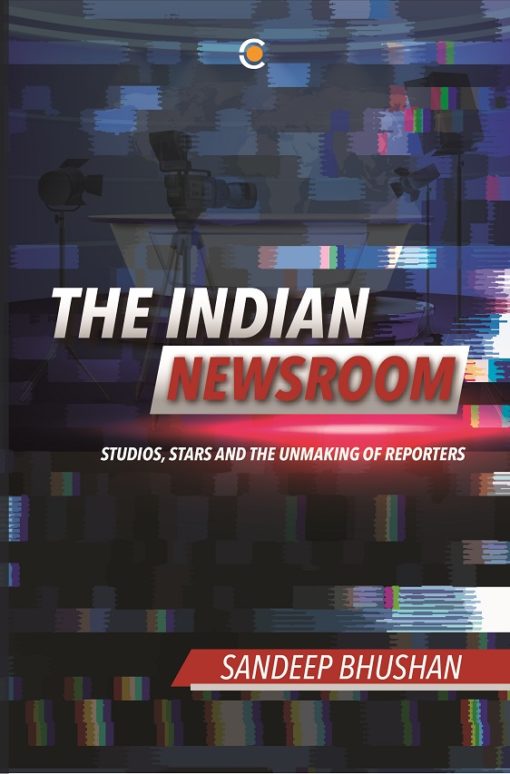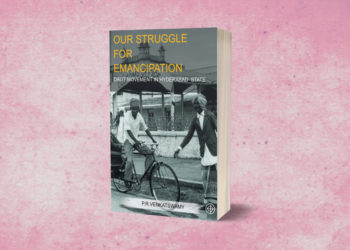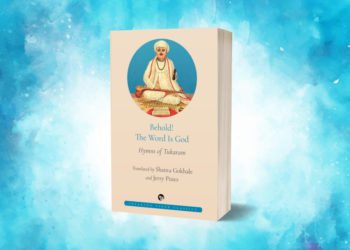Written by Sandeep Bhushan, The Indian Newsroom is a behind-the-scenes look at the crisis in news television. It is both a political and personal history, that the journalist and author narrates. Economic liberalisation led to the shift from a state-owned monopoly to a market replete with privately owned news channels, from the book we learn what it has cost.

The Age of Fake News and Agenda Journalism
The culture of breaking news from the studio is a direct consequence of the devaluation of facts and, by implication, the reporter’s job. It is the reporter who is the prime purveyor of facts—an inextricable part of their profile. But with the privileging of the studio, it is hardly a surprise that the phenomenon of fake news or ‘alternative facts’ has assumed epidemic proportions. This is particularly true in our broadcast culture. In perhaps no other country is the mainstream media—especially television—as complicit in spreading fake news.
A recurrent source of fake news is social media. In a post-truth that favours alternative facts, the process of checking a statement or claim is given a go-by. Neither do newsrooms have any gatekeepers, nor are networks or their editors bound by regulatory norms. In a pyramidal arrangement, the buck stops at the editor. Once they clear a story, it’s enough. This attitude has perpetuated the phenomenon of fake news on a scale that was unimaginable a few years ago. Add to this sources embedded in the bureaucratic and political power structure and the need to grab eyeballs and nose ahead of rivals at any cost. The result: fake news has begun to substitute good, rigorously researched content. The lack of serious reporting seriously compounds this crisis.
In India, the problem of fake news has been exacerbated post-2014 because of its widespread dissemination by the BJP’s social media cell. With the possible exception of Russia, there are few democracies today where the ruling party actively promotes slander and fake news against dissenters of all stripes—Opposition leaders, journalists, academics. Some of the support to this phenomenon originates from the perception that the mainstream liberal media has always given the BJP a raw deal. The practice has become woven into the larger aims of the state and its leading actors, who suffer from a persecution complex about the liberal media and public opinion at large. But with its fake discourse, meant to appease the ruling party, the right-wing media has caused serious damage to the credibility of mainstream news TV as a whole.
Sardesai spoke about how it has become common to cleverly edit videos and photos and use them as a propaganda weapon. False images have been used to attack a person, demonise a community or even incite a riot. ‘I recall during the Muzaffarnagar riots in 2013, images from the war in Afghanistan were sent out as WhatsApp messages and spread with impunity as if the violence was taking place on the ground in Uttar Pradesh …’ He expressed alarm about mainstream media falling prey to this culture and losing its moral centre. ‘We are now becoming rabble-rousers, imitating the very politicians that we once shunned.’
These trends have become more pronounced since the launch of Republic and its TRP battle with long-time market leader Times Now. In August, the former ran a campaign-mode story that the Imam of Delhi’s Jama Masjid, who apparently has a fleet of luxury cars, had not paid his electricity bill, amounting to around ₹4 crore. It came to light in a few days that the story was four years old, and the matter was between the Imam and the Delhi Wakf Board. In June 2017, Times Now ran another outrage-filled news item on the ‘rate card’ for conversions to Islam in Kerala. It was billed as the handiwork of ISIS, which was looking to establish a caliphate in the state. Turned out it was a seven-year-old story, and fake to boot. Not to be left behind, ANI carried a report on how the Rohingyas were planning to attack Nagaland. The news agency later took it down.1
The worst part about all this is that there is never any retraction. Our ‘North Korean’ channels—as the well-known journalist Arun Shourie calls pro-government networks and their copycats2—simply move ahead with yet another fake news item. Even Fox News observes certain rules of the game, perhaps owing to regulators, who have more teeth than India’s self-regulated television media. In October 2017, the American network ran a story on how a highly commended former Navy SEAL-cum-Vietnam War veteran had crafted a presidential glass seal that he hoped to present to Donald Trump. Later, it emerged that he was neither a former Navy SEAL nor a war veteran. But Fox News, unlike our channels, pulled back the story and even issued an apology.3
Fake news not only indicts news networks as puppets of the establishment, it also helps them disguise toadying using the time-tested trope of outrage. Rhetoric and outrage against the state are understandable. But attacking the Opposition and the powerless? This is because outrage looks for villains in the plot, and the weak and the relatively powerless are more comfortable targets. Outrage also creates an ideological smokescreen for the ruling party, even as it demonises the Opposition. Facts or the lack of them in such a situation are of no consideration. If there aren’t enough, then simply manufacture them. Anyone will do—Muslims, Dalits, Kashmiris—as long as the issue can make its way seamlessly into the government’s electoral strategy and policy regime. It’s a win–lose situation—‘win’ for the government of the day, ‘lose’ for media credibility.
A bigger risk of news breaking in studios is agenda journalism. It is now ridiculously easy to plant stories in the media. There are numerous instances of sensational stories timed to parliament sessions and promoted in campaign mode. A narrative parallel to the studio harangue is sought to be built on the floor of the house through questions, disruptions and walkouts. In the course of such campaigns, new elements and ‘exclusive angles’ relentlessly trickle in as breaking news. No attempts are made to reach out to the affected party or individual in question. Who can forget the Ishrat Jahan case and the procession of exclusives on Times Now (helmed by Goswami), which coincided with one such session? Or the stand-off between the government and JNU students, which triggered a manufactured outrage over nationalism versus anti-nationalism in the run-up to the 2016 budget session? The original story that later ran into a controversy over allegedly doctored footage was aired by Zee, a channel on friendly terms with the government. The examples are numerous, and any reporter worth their salt in Delhi knows which ministers plant stories in the media and the true extent of their proximity to editors.
1. ANI Publishes Fake News About Possible Rohingya Attack In Nagaland, Apologises’, Huffington Post, 16 October 2017, https://www.huffingtonpost.in/2017/10/16/ani-publishes-fake-news-about-possible-rohingya-attack-in-nagaland-apologises_a_23244282/, accessed on 10 November 2018.
2. Arun Shourie on @OnReality_Check: “Some news media have become like North Korean channels”’, 6 June 2017, https://twitter.com/ndtv/status/872159362105593856?lang=en, accessed on 10 November 2018.
3. Travis M. Andrews, ‘Retired “Navy SEAL” praising Trump on Fox News was a fake’, Washington Post, 20 October 2017, https://www.washingtonpost.com/news/morning-mix/wp/2017/10/20/




